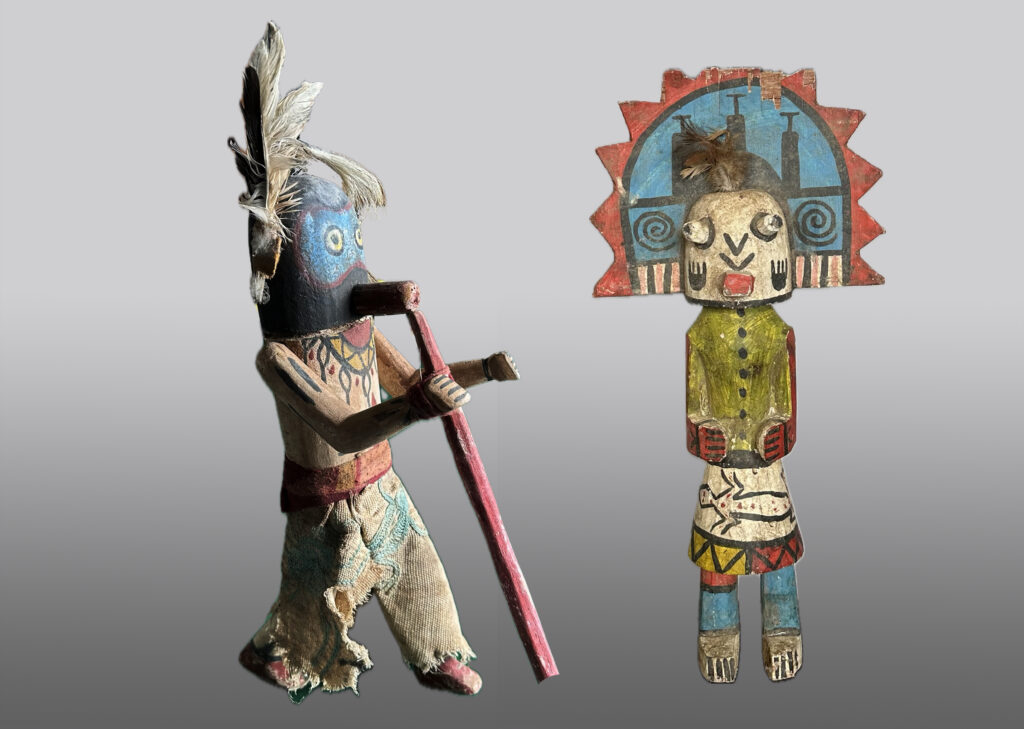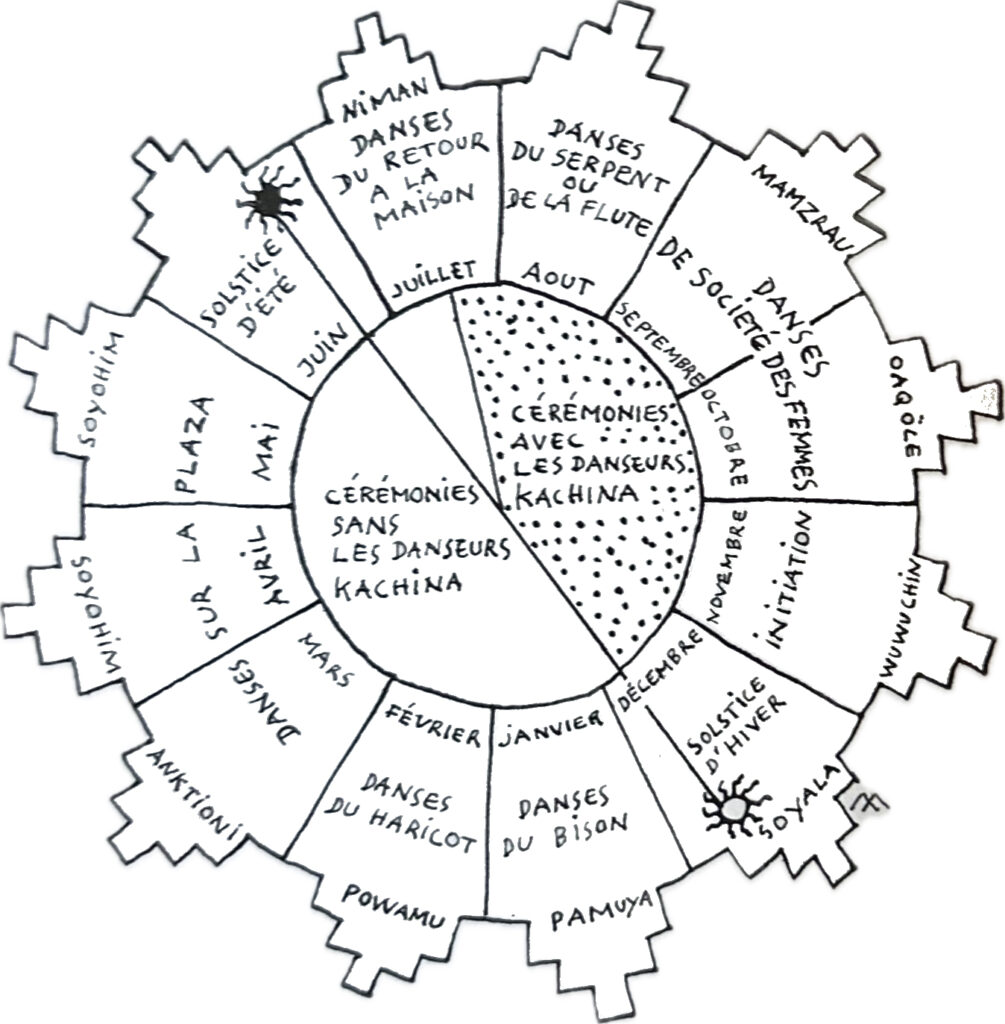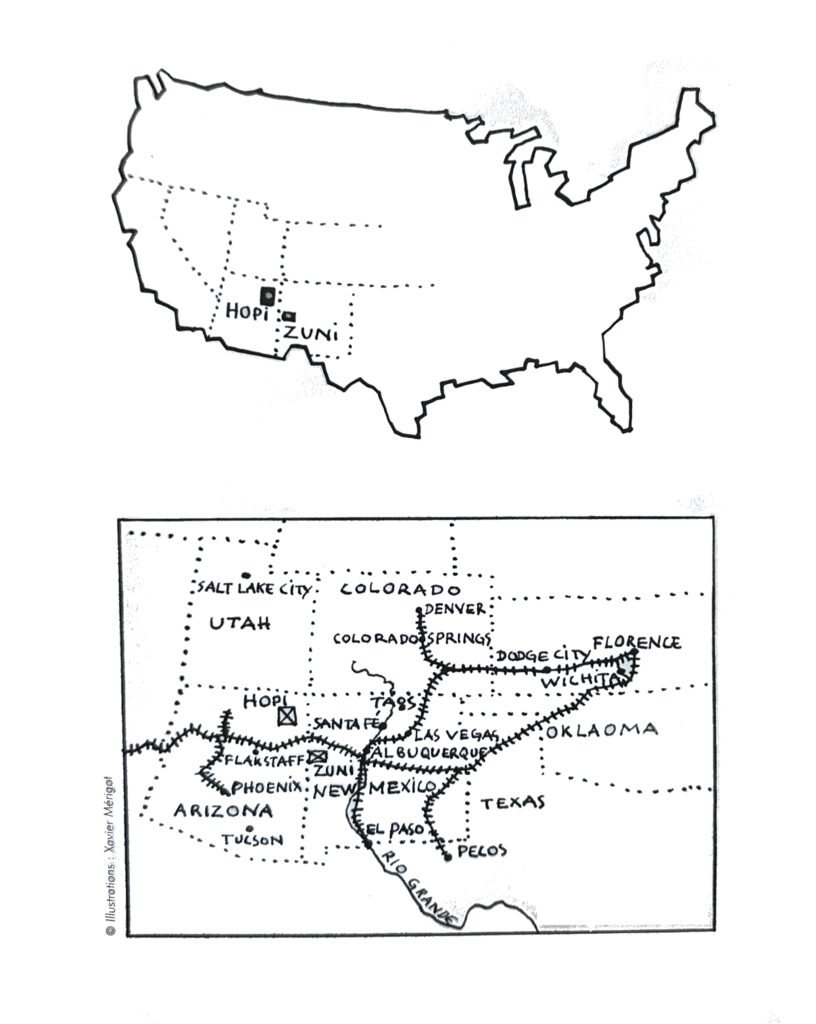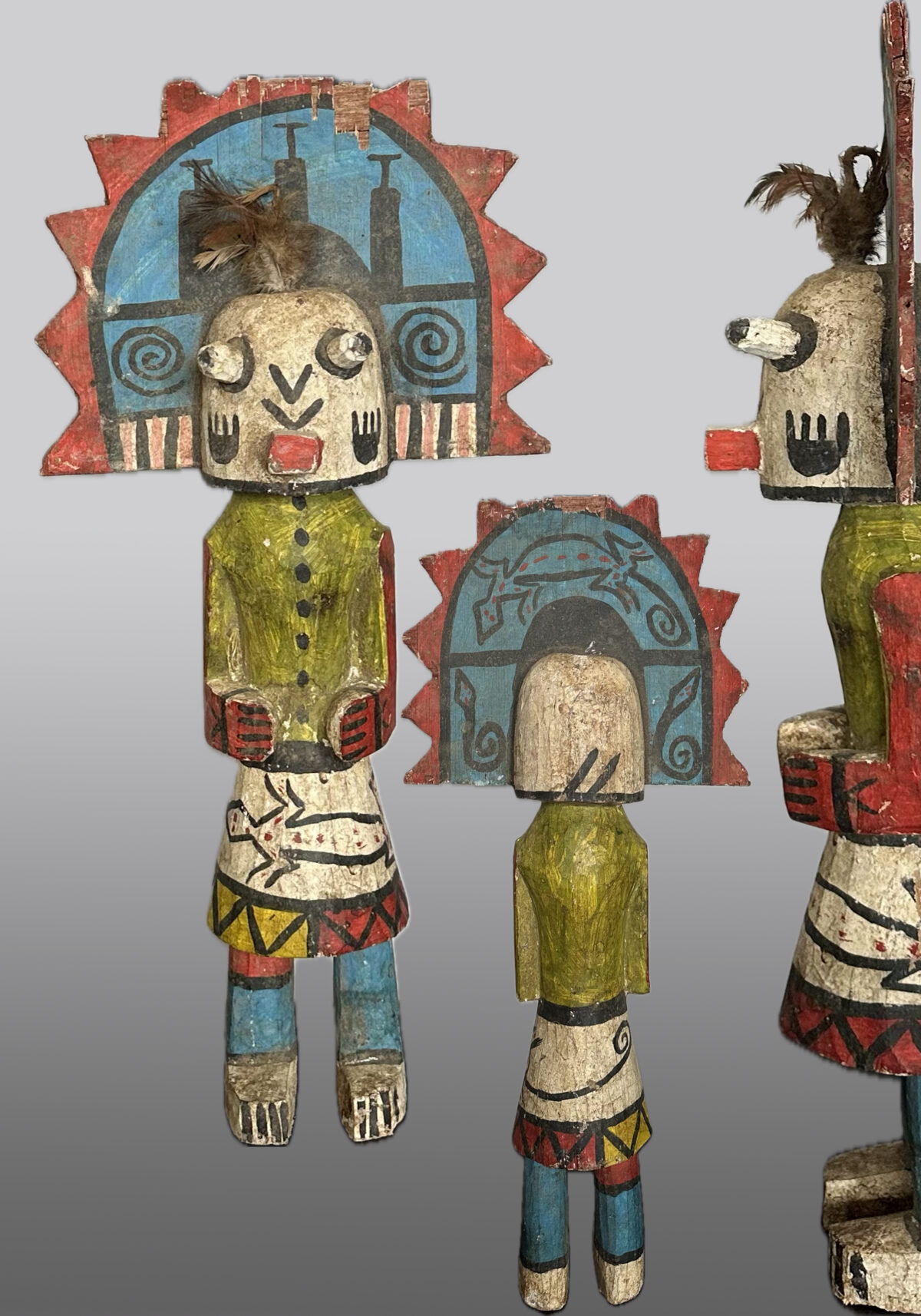
Li abbiamo defraudati anche dei nomi. Troppo difficili da pronunciare. Così i nativi Americani sono diventati “Indiani”; i primi invasori di quelle terre , ignoranti oltre che avidi, erano convinti di essere nelle indie…Uso la prima persona plurale come incipit per questo testo perché siamo stati proprio noi, i bianchi-occidentali-cristiani ad iniziare, perseguire e concludere il più grande genocidio della storia dell’umanità, un genocidio plurimo. Proprio noi..il primo invasore era ligure..ed a partire dal 12 ottobre 1492 decine, ragionevolmente centinaia di culture originali, complesse e secolari sono state cancellate. Non sarebbe moralmente accettabile iniziare un qualunque ragionamento che riguardi i Nativi Americani senza questa premessa.
Il caso degli Hopi è esattamente dentro questi parametri. Quel popolo vive sul vasto altipiano ribattezzato dagli invasori bianchi Black Mesa. E’ una zona desertica, che alterna rocce e sabbia fino a 2000 metri di altitudine; le temperature oscillano tra -20 e +40 gradi. Conseguentemente gli Hopi hanno sviluppato un sistema di agricoltura adeguato che garantisca la loro sussistenza, sfruttando ogni elemento del loro ambiente. Piantano il mais, alimento principale, utilizzando una sorta di bastone da trapianto e scavano una buca profonda da venticinque a cinque centimetri che non rompe la superficie del terreno e impedisce l’evaporazione dell’umidità sottostante. I buchi sono molto distanziati e in ognuno di essi depositano al massimo sei semi.
Si dice che piantano un seme per il vento o per il gelo, uno per i topi, uno per i corvi e due o tre per se stessi. Si ritiene che questi semi siano un segnale al dio della germinazione in modo che ciò possa accadere . Un appezzamento di mais viene seminato in due luoghi diversi, su terreno asciutto dove possono verificarsi inondazioni. Pertanto, se un appezzamento viene spazzato via da un’inondazione, l’altro può essere salvato. Se però non piove, spesso nel sottosuolo rimane abbastanza umidità residua per produrre un piccolo raccolto.
Chi coltiva ha bisogno di ogni aiuto possibile per vivere in questo ambiente. Per questo gli Hopi invocano il mondo degli spiriti messaggeri, i Kachina, che trasmettono le loro preghiere alle divinità. Sono gli uomini ad occuparsene, insieme ad ogni aspetto connesso alla agricoltura e alla guerra, intese nella loro dimensione religiosa. Sono però le donne a possedere la terra, la responsabilità della famiglia ed ogni forma di autorità. Si può dire che esse sono la fonte, il nucleo della vita Hopi, a cui gli uomini devono fornire sostentamento e protezione. Profondamente convinti che ogni cosa – animali, piante umani, spiriti, vivi o morti – sia strettamente correlata e reciprocamente dipendente, gli Hopi hanno creato un sistema ordinato di comportamenti, precisamente stabiliti indipendentemente dall’età. Il mondo soprannaturale è speculare a quello reale , anche se popolato da divinità, semidei, Kachina, mostri e antenati, e le loro vite rispecchiano quelle degli Hopi, sebbene abbiano il potere di controllare ogni aspetto dell’ambiente.
I Kachina prendono forma e vita attraverso i danzatori, protagonisti dei diversi riti che scandiscono il ciclo rituale della Comunità, e si riconoscono in relazione alle maschere che indossano, al costume ed al particolare tipo di movimento che fanno. Sono scolpiti anche sotto forma di bambole, chiamate Tihu, strumento mnemonico rivolto ai più giovani e destinato a tramandare la visione del mondo HOPI. Il legno usato è il pioppo americano, la forma è cambiata nel corso dei decenni; nelle più antiche, anteriori al 1870, gli arti sono abbozzati direttamente dal tronco, in seguito si iniziò a realizzare braccia articolate che meglio rispecchiassero i movimenti del ballerini. I colori hanno valore simbolico, riferito ai punti cardinali: giallo per il nord, blu-verde per l’ovest, rosso per il sud, bianco per l’est. Il nero raffigura lo zenit, l’insieme di colori o il grigio il nadir. I diversi toni e i simboli rimandano alle appartenenze claniche ed a specifiche funzioni.

Xavier Mérigot per Esprit Kachina
Sono stati i Surrealisti, ed in particolare Andrè Breton, i primi a comprendere la potenza evocativa di questi oggetti ed a farli conoscere. Rimando al testo di Pierre Amrouche “ Kachina and Surrealism” pubblicato in “Esprit Kachina” ( Galerie Flack, Parigi 2003, testo di riferimento fondamentale per approfondire la conoscenza di queste formidabili sculture.
We even cheated them of their names. Too difficult to pronounce. Thus Native Americans became “Indians”; the first invaders of those lands, ignorant as well as greedy, were convinced that they were in the Indies…I use the first person plural as an incipit for this text because it was we, the white-Western-Christians who started, pursued and concluded the greatest genocide in the history of humanity, a multiple genocide. Just us… the first invader was Ligurian… and starting from 12 October 1492 dozens, reasonably hundreds of original, complex and centuries-old cultures were erased. It would not be morally acceptable to begin any argument regarding Native Americans without this premise.
The case of the Hopi is exactly within these parameters. Those people live on the vast plateau renamed Black Mesa by the white invaders. It is a desert area, which alternates rocks and sand up to 2000 meters above sea level; temperatures fluctuate between -20 and +40 degrees. Consequently, the Hopi have developed an adequate agricultural system that guarantees their subsistence, exploiting every element of their environment. They plant corn, the main food, using a sort of transplanting stick and dig a hole twenty-five to five centimeters deep that does not break the surface of the soil and prevents the evaporation of the underlying moisture. The holes are widely spaced and a maximum of six seeds are deposited in each of them.
It is said that they plant one seed for wind or frost, one for mice, one for crows, and two or three for themselves. It is believed that these seeds are a signal to the god of germination so that a particular species of corn can germinate in this place. A plot of corn is planted in two different locations, on dry soil where flooding can occur. Therefore, if one plot is washed away by a flood, the other can be saved. However, if it doesn’t rain, there is often enough residual moisture left underground to produce a small crop.
Farmers need all the help they can get to live in this environment. For this reason the Hopi invoke the world of messenger spirits, the Kachina, who transmit their prayers to the deities. It is men who deal with it, together with every aspect connected to agriculture and war, understood in their religious dimension. However, it is women who own the land, the responsibility of the family and every form of authority. It can be said that they are the source, the nucleus of Hopi life, to which men must provide sustenance and protection. Deeply convinced that everything – animals, plants, humans, spirits, living or dead – is closely related and mutually dependent, the Hopi have created an ordered system of behaviors, precisely established regardless of age. The supernatural world is a mirror image of the real one, although populated by deities, demigods, Kachina, monsters and ancestors, and their lives mirror those of the Hopi, although they have the power to control every aspect of the environment.
The Kachina take shape and life through the dancers, protagonists of the various rites that mark the ritual cycle of the Community, and are recognized in relation to the masks they wear, the costume and the particular type of movement they make. They are also sculpted in the form of dolls, called Tihu, a mnemonic tool aimed at younger people and intended to pass on the HOPI worldview. The wood used is American poplar, the shape has changed over the decades; in the oldest ones, prior to 1870, the limbs are sketched directly from the trunk, later they began to create articulated arms that better reflected the movements of the dancers. The colors have symbolic value, referring to the cardinal points: yellow for the north, blue-green for the west, red for the south, white for the east. Black represents the zenith, the set of colors or gray the nadir. The different tones and symbols refer to clan memberships and specific functions.
It was the Surrealists, and in particular Andrè Breton, who were the first to understand the evocative power of these objects and make them known. I refer to Pierre Amrouche’s text “Kachina and Surrealism” published in “Esprit Kachina” (Galerie Flack, Paris 2003, a fundamental reference text for deepening knowledge of these formidable sculptures.


Una risposta su “Kachina.”
[…] Info sulle bambole Kachina qui https://www.mapmuseum.it/2024/04/17/kachina/ […]